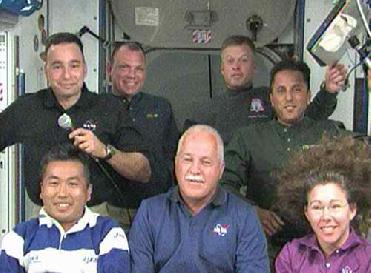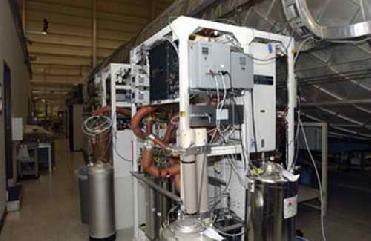
Shuttle and station astronauts participate in an in-flight media interview. Photo credit: NASA TV
WASHINGTON (BNS): Astronauts aboard the linked International Space Station and Shuttle Discovery have been ordered to move out of the way of space junk approaching their home.
On instructions from NASA, Discovery’s pilots fired their ship’s thrusters to reorient the two spacecraft and thereby avoid a small piece from a 10-year-old Chinese satellite rocket motor that was due to pass uncomfortably close during Monday’s planned spacewalk.
According to NASA the station and the shuttle were turned 180 degrees, with the shuttle leading the station as it orbits the Earth.
Mission managers said that keeping the spacecraft in this position for about three hours, with Discovery’s belly facing forward, would result in a slow, natural drag of about a foot per second, and lower their orbit just enough to avoid a 4-inch piece of debris threatening the station.
“Had we not taken this action, the first time of closest approach would have been about two hours into Monday’s spacewalk,” NASA said in a statement.
This is the third time in a span of a month that the astronauts have been asked to take precautions from approaching space debris. NASA said that earlier, the three space station residents had to take shelter in the Russian spacecraft when another piece of orbital debris seemed like it might come too close.
Last week just before Discovery’s arrival at the space station, the residents almost had to dodge yet another piece of junk. However, it did not cause any damage and kept a safe distance. The debris was from an old busted-up Soviet satellite. For this NASA had planned to move the space station to avoid a collision with a piece of debris from a Russian satellite. But it said later that there was no danger. At that time, New Scientist quoted NASA’s orbital debris programme manager Gene Stansbery as saying that tracking data suggests that the debris was a 10-cm portion of Soviet era Cosmos 1275, a military navigation satellite that was launched in 1981.
“Pieces of the satellite, which broke up not long after reaching orbit, have progressively lost altitude due to the drag of Earth’s atmosphere, so that they now come within the space station’s altitude,” Stansbery said.
Flight director Kwatsi Alibaruho said on Sunday that space debris was becoming an ever-increasing challenge. “When it comes to dodging junk, it's a big deal. It's very tiring. Sometimes it's exhausting,” Alibaruho said.
The flight director said that the latest space debris occurred as NASA rushes to put together a spacewalking repair plan for a jammed equipment platform at the space station.
In spite of the recent incidents, Discovery’s astronauts said that they are not worried about the space junk when they’re outside. “We have enough other risks and worries to take on as we go outside,” said Steven Swanson, who has participated in the first two spacewalks.
NASA said on the third and final spacewalk of Discovery's mission, on Monday, astronauts plan to return to an equipment storage shelf that jammed and could not be deployed on Saturday. The spacewalkers accidentally had inserted a pin upside down.
The flight director said that this could not be the catch for the mechanism is considerably stiffer than expected and engineers now believe the upside-down pin might not be the culprit after all.
Monday’s spacewalkers, former schoolteachers Joseph Acaba and Richard Arnold II, will use all their strength this time to get the shelf properly deployed. They will have pry bars and hammers, just in case. If nothing works, the jammed platform will simply be tied down with sturdier tethers, the flight director said.
NASA said that a hastily assembled team of experts spent Saturday and Sunday trying to figure out how best to deal with the problem.
 Next Article
Next Article













The Indian Air Force, in its flight trials evaluation report submitted before the Defence Ministry l..
view articleAn insight into the Medium Multi-Role Combat Aircraft competition...
view articleSky enthusiasts can now spot the International Space Station (ISS) commanded by Indian-American astr..
view article